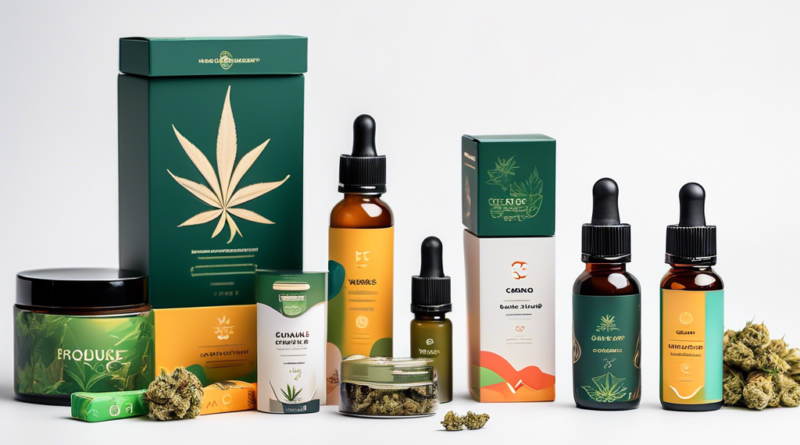Understanding the Role of Packaging in Cannabis Marketing
In the ever-evolving cannabis industry, packaging plays a pivotal role in shaping both brand identity and consumer perception. As a crucial element of cannabis branding, packaging serves not just as a container but as a powerful marketing tool that can make or break a product’s market success. With a plethora of types and trends emerging, understanding how to utilize custom designs and logos can significantly enhance brand recognition and loyalty.
Beyond aesthetics, cannabis packaging must also navigate a complex web of legal requirements and regulatory standards to ensure full compliance. This involves adhering to stringent guidelines that protect public safety while maintaining the brand’s integrity.
Functionally, effective cannabis packaging prioritizes safety with child-resistant features and tamper-evident seals, addressing critical health concerns from regulators and parents alike. Additionally, preserving product quality is paramount; airtight seals and UV-blocking materials are essential to maintain the freshness and potency of cannabis products.
In today’s environmentally conscious market, eco-friendly packaging solutions are more than a trend—they are a necessity. Utilizing sustainable materials not only reduces the environmental footprint but also appeals to the growing segment of eco-aware consumers. Thus, cannabis packaging transcends mere functionality, becoming a keystone of effective marketing strategy.
The Importance of Packaging in Cannabis Branding
Introduction to Cannabis Packaging: Types and Trends
Packaging serves as the initial touchpoint between a cannabis brand and its consumers. With an array of types and trends shaping the industry, selecting the right packaging can significantly impact a product’s market presence. Common types of cannabis packaging include glass jars, resealable bags, tins, and paper boxes. Each offers distinct benefits; for example, glass jars are known for their durability and product visibility, while resealable bags offer convenience and portability.
Current trends emphasize minimalistic design, eco-friendly materials, and child-resistant features. Minimalistic design, characterized by clean lines and simple graphics, allows the product to speak for itself, appealing to a sophisticated consumer base. Eco-friendly materials, such as biodegradable plastics and reusable glass, address growing environmental concerns, enhancing a brand’s appeal to environmentally-conscious consumers.
Enhancing Brand Identity: Custom Designs and Logos
One of the most critical aspects of cannabis packaging is enhancing brand identity. Custom designs and logos play a pivotal role in differentiating a brand in a crowded marketplace. A package adorned with a unique logo and distinctive design elements can create a strong, memorable impression, making it easier for consumers to recognize and recall the brand.
Strategically-designed packaging not only captures attention but also communicates the brand’s story and values. For instance, a brand that prioritizes purity and natural ingredients may use earthy colors and organic shapes in its packaging. Conversely, a brand targeting a luxury market might opt for high-end materials like metallic foils and embossed lettering. By aligning packaging design with brand identity, companies can foster a deeper connection with their audience.
Ensuring Compliance: Legal Requirements and Regulatory Standards
In the cannabis industry, ensuring compliance with legal requirements and regulatory standards is paramount. Failure to adhere to these regulations can result in severe penalties, including fines and loss of business licenses. Each region may have unique laws governing cannabis packaging, necessitating careful attention to detail.
Key compliance aspects include child-resistant features, proper labeling, and tamper-evident seals. Child-resistant packaging is designed to be significantly challenging for children to open, thereby reducing the risk of accidental ingestion. Proper labeling involves including essential information such as product contents, dosage recommendations, THC/CBD levels, and warning messages. Tamper-evident seals provide assurance that the product has not been compromised after packaging.
By ensuring that all packaging adheres to these regulatory standards, cannabis brands not only safeguard public health but also demonstrate their commitment to ethical business practices. This adherence to compliance fosters trust and credibility among consumers and reinforces the legitimacy of the brand in the eyes of regulators and stakeholders.
In summary, the importance of packaging in cannabis branding cannot be overstated. From embracing current trends and enhancing brand identity to ensuring strict regulatory compliance, packaging serves as a cornerstone of successful cannabis marketing.
Excelligenix Media- Perfect Cannabis Marketing

Functional Aspects of Cannabis Packaging
Safety First: Child-Resistant Features and Tamper-Evident Seals
Ensuring the safety of cannabis products is paramount, and one of the primary responsibilities of packaging is to prevent unauthorized access, particularly by children. Child-resistant features have become industry standards, driven by regulatory requirements and consumer safety concerns. Packaging should be designed such that it requires a combination of actions that are challenging for children under the age of five to perform, but straightforward for adults. This includes push-and-turn caps, squeeze-and-turn lids, and other mechanisms that demand dexterity.
Additionally, tamper-evident seals are crucial for maintaining the integrity of cannabis products. These seals provide clear evidence if the product has been opened or tampered with before purchase. By incorporating both child-resistant features and tamper-evident seals, cannabis packaging not only complies with legal standards but also builds trust with consumers, showcasing the brand’s commitment to safety and quality.
Preserving Product Quality: Airtight Seals and UV-Blocking Materials
The efficacy of cannabis largely depends on the preservation of its freshness, potency, and flavor. This makes the use of airtight packaging indispensable. Airtight seals prevent the intrusion of air, moisture, and contaminants, thereby extending the shelf life of the product. Containers such as glass jars with rubber gaskets or mylar bags with secure zippers are effective in protecting the product from environmental factors.
Moreover, cannabis is sensitive to light, particularly UV light, which can degrade cannabinoids and terpenes, reducing the product’s effectiveness. Thus, utilizing packaging materials that block or filter UV rays is essential. This is where opaque or tinted glass containers and specially coated plastic materials come into play. By integrating these protective elements, cannabis packaging ensures that the product reaches the consumer in optimal condition, contributing to overall customer satisfaction and loyalty.
Eco-Friendly Packaging: Sustainable Materials and Consumer Appeal
As consumers become increasingly environmentally conscious, the demand for sustainable packaging solutions is on the rise. The cannabis industry is not exempt from this trend. Brands that adopt eco-friendly packaging options can appeal to a broader audience and distinguish themselves in a competitive market. Sustainable materials include biodegradable plastics, recycled paper, and hemp-based containers. These materials reduce environmental impact and align with the principles of green consumption.
Implementation of eco-friendly packaging not only helps the environment but also enhances brand reputation. Consumers are more likely to support companies that demonstrate a commitment to sustainability. By investing in innovative, sustainable packaging, cannabis brands can boost their market presence, appeal to eco-conscious consumers, and potentially increase their market share.
In conclusion, the role of packaging in cannabis marketing cannot be overstated. As the cannabis industry continues to evolve, the ways in which products are packaged will play a crucial role in shaping consumer perceptions and brand identity. Custom designs and logos not only enhance brand recognition but also set a product apart in an increasingly competitive market. Furthermore, compliance with legal requirements and regulatory standards ensures that a brand not only meets industry benchmarks but also gains consumer trust.
On the functional side, packaging must prioritize safety with child-resistant features and tamper-evident seals, addressing key consumer concerns. Equally important is the need to preserve product quality through airtight seals and UV-blocking materials, preventing degradation and maintaining the product’s efficacy. Additionally, the growing demand for eco-friendly packaging highlights the industry’s shift towards sustainability, appealing to environmentally conscious consumers.
By meticulously balancing branding, safety, product preservation, and sustainability, cannabis companies can not only meet but exceed market expectations, establishing a strong and reputable presence in the market.

